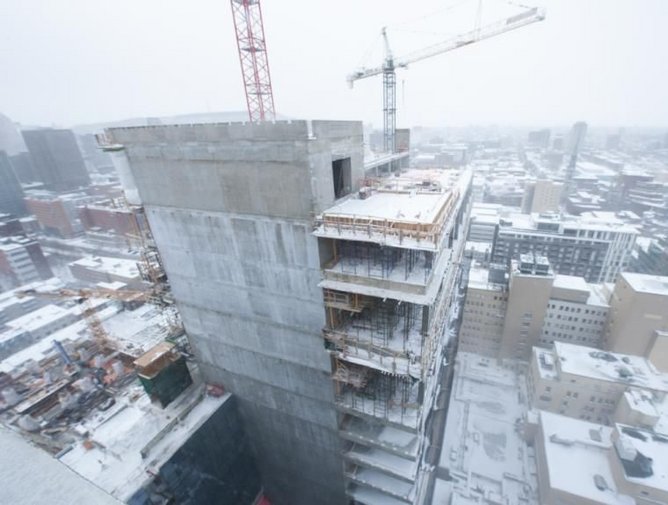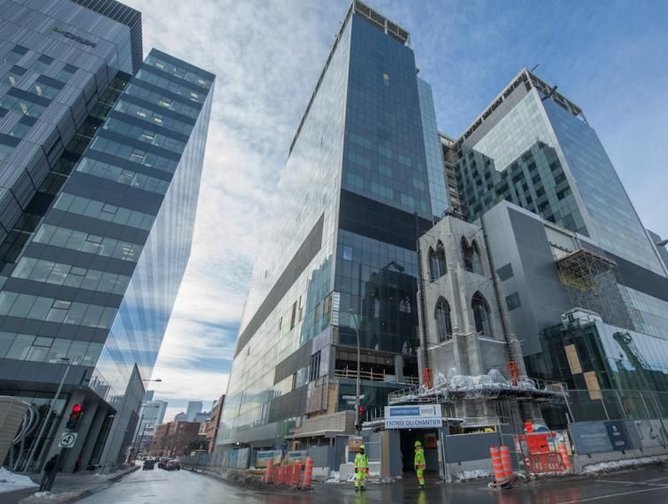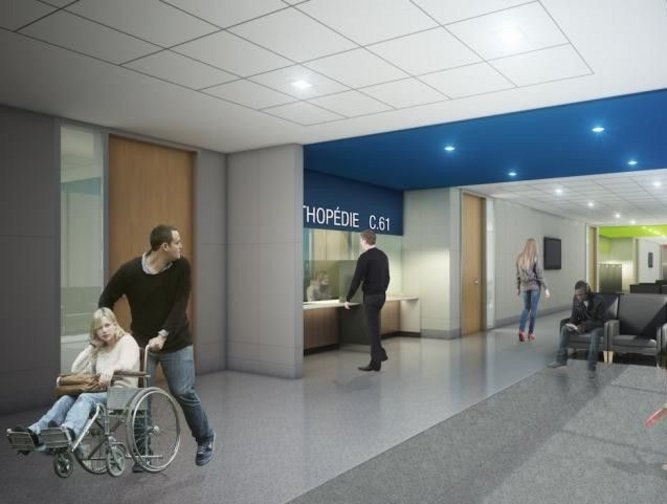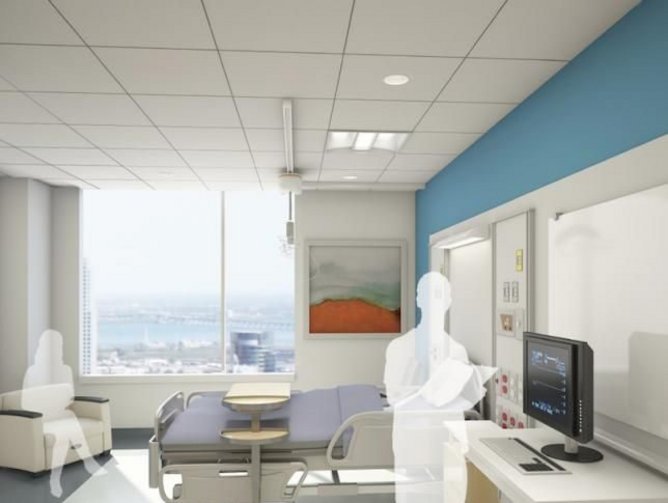Located in the heart of Quebec’s largest city, the CHUM is an international reference for academic medicine and research. Its health research center (CRCHUM) is the largest in the university network.
Born from the merger of three founding hospitals (Hotel Dieu, Hopital St. Luc, and Hopital Notre-Dame) medical education and research has always been at the heart of its mission and vision. The hospital is now undergoing an extensive transformation towards a new teaching hospital facility and fulfilling its goal of becoming a major academic health center renowned worldwide.
The redevelopment project consists of three construction phases spanning a 10 year period. It is a complex redevelopment project in the city center, near Old Montreal, and has been procured under a 34 year private-public partnership (P3) agreement. The new CHUM is a state-of-the-art academic medical center that will include 772 beds, 39 operating rooms, a cancer center, a research center and an education simulation center.
Phase 1
The CHUM Research Centre and Integrated Education Centre is contiguous to the new health center complex. It would not exist without the hospital. Conversely, the CHUM would not be an international academic medical center without the research and education facilities.
Contributing closely to the five components of CHUM’s mission—care, teaching, research, health promotion and evaluation of technologies—today, more than 360 researchers and almost 450 students contribute to the large-scale production and international reputation of the center.
In March 2010, the approval was given for the construction of a new research center—preceding the construction of the new CHUM.
In the first phase of this project, six old research centers were merged to consolidate the expertise of both researchers and students.
“The research center was built for $475M and was completed on time and within budget,” said Jacques Turgeon, CEO of CHUM, during a recent interview. “It has been operating since October 2013.”
Encompassing 68,000 square meters, the center is one of the largest research centers in North America and one of the first to bring together under one roof a comprehensive continuum of research.
Phase 2 and 3
The two subsequent phases of the project encompass the new teaching hospital facilities. The main hospital towers are scheduled to open in the Fall of 2016, and the 3rd and final phase includes a medical office building and 500 seat academic conference center.
The new CHUM will replace older facilities that currently sit on three sites— Hôpital Saint-Luc, Hôtel-Dieu and Hôpital Notre-Dame. One of the facilities—Hôpital Notre-Dame—will remain as a regional-type hospital with approximately 300 beds. Together with the new CHUM hospital development there will be a total of 1,072 beds in operation upon completion.
Hôtel-Dieu will likely be used as a long-term care facility in the future, according to Turgeon.
The new CHUM is being built on the existing site of the Hôpital Saint-Luc, within a couple of meters of the existing buildings.
“From a construction perspective, it’s very complex to be building so close to the existing hospital,” said Paul Landry, Project Director of the CHUM redevelopment project. “Complex construction logistics for a building that is over 3 million square feet and 22 stories in height.”
The selection of the site for the new CHUM was quite strategic, according to Landry. Right beside a major highway system, the new CHUM also links to a regional train system, solving transportation issues previously encountered on the existing older sites.
“We are quite pleased with the vertical scale of the new hosptal” said Landry. “It is designed so that right from the ground floor, or even the lower levels of parking, it’s a matter of taking an elevator and going straight up to one of 35 specialty clinics or of 26 inpatient units. The patient and staff displacement is very efficient.”
The third phase of the project is a doctors’ office building and a 500-seat amphitheater which sit on top of four stories of underground parking (1,350 parking spaces). The ambulatory care center encompasses the outpatient clinics with over 45 exam and treatment rooms.
Prior to commencing construction of Phase 3, the Hôpital Saint-Luc will be demolished and Phase 3 will be built in its place. Substantial completion of Phase 3 is scheduled for March 2020.
Focused Research
The CHUM primarily provides care and subspecialty services to a regional and supra regional adult population.
“We have identified some themes that allow us to work amongst the best researchers in the world,” said Turgeon. “So we’re very aligned with the specialties we have in our hospital population.”
Among those specialties are oncology, breast cancer, ovarian cancer, endometrial cancer and prostate cancer.
“We’re also looking at dyskinesia, or neurological diseases of the movements,” added Turgeon. “So whenever there’s a movement associated with a disease, this is what we’re looking at. We’re also looking at immunity and transplantation to make sure to have most of the major transplantation programs, such as liver, kidney, lungs, heart and lungs, intestine and pancreas.” Moreover, the CHUM focuses on metabolic syndromes—diabetes, Type 2 diabetes, pancreatic transplantation and insulin replacement.
A Specialized Supply Chain
Entirely new for the CHUM will be the implementation of an AGV system (Automated Guided Vehicles) that will transport supplies, soiled and recyclable materials throughout the 22-story hospital complex.
“Using dedicated elevators, approximately 70 Wi-Fi guided robotic AGVs will perform most deliveries up to the various logistics lobbies adjacent to the inpatient units” said Landry.
Furthermore, the new CHUM is quite different from current supply chain functions in that the CHUM has entered into a contract with another teaching hospital in Montreal—the McGill University Health Center—for an off-site central distribution facility.
“The whole supply chain has been re-planned and the AGV robots will be the transport mechanism for that supply chain,” added Landry.
Improving Operations
One of the major features in the new CHUM will be the electronic integration amongst all 772 single rooms. “We’re trying to limit infections or transmission of infection from one patient to another,” explained Turgeon.
Another major feature is the state-of-the-art equipment in the 39 surgery rooms.
“We will become a center for tertiary and quaternary care, which means being specialized, and ultra-specialized, in some very specific diseases for better patient care.”
“While this is a huge mega-hospital development of some 3 and a half million square feet and quite vertical, it's also a huge transformation of the hospital’s operations,” added Landry. “We’ve gone through a very complex, very thorough, multiple years of planning—looking at our work processes, new technologies, looking at how we can become more efficient at delivering care, so you know, there’s a large focus on this massive transformation that we have to undergo to move into this new teaching hospital complex.”
Communication challenges
Even though the hospital will be ready to welcome its first patients in fall 2016, “we have to start communicating from now on with our patients. First of all, we have to promote the project as a major healthcare project. Secondly, we also have to reassure the patients and our employees about the transformation and the move. Since some patients will have their next appointment in more than a year, we have to plan ahead and find the best way to inform them as to where and when it will take place”, explained Irene Marcheterre, Communication and Information Access Director.
The construction site of the new CHUM is located in downtown Montreal which is an urban district, next to Saint-Luc Hospital; therefore communication programs for the community (residents and merchants of the area) and for the medical team of the existing hospital where prepared a few years ago and are still being applied.
The management of the negative or even harmful impacts (street closures, noise) had to be well planned and consider community sensitivities. “Therefore, we have special meetings for the locals twice a year where we provide information about the evolution of the project and respond – with the builder – to the questions from the public. We also plan other types of activities to facilitate our integration and to participate to the area revitalization”, said Irene Marcheterre.
There are also some communication challenges related to the human resources: “each of our three hospitals has its own culture. We have to mobilize the doctors, the health workers and all the administrative employees in order to have a successful transformation”, said Irene Marcheterre. Promoting the project is important, but more importantly is to listen to staff concerns and preoccupations, she adds.
What makes the new CHUM a one of kind major project is of course its architecture, well integrated to the urban fabric and the historical heritage of this district, but also its openness to art. The Quebec integration of art to the architecture policy makes sure that any public construction project allows a portion of its budget to public art. Therefore, the new CHUM will have 13 works of art (5 M$) within its walls to create a healing and calming environment.
Looking Ahead
“The major goal that I have as a CEO is to position this hospital as one of the major academic hospitals in the world, in order to be at the level of the major academic centers in the United States,” said Turgeon.
“There’s so much that awaits the patients at the end of this journey,” added Landry. “There’s a lot of exciting new technology that will be available to staff and patients, but the patient care will remain at the center of our mission”.
Phase 2 of construction is currently on schedule to be completed by April 2016.











